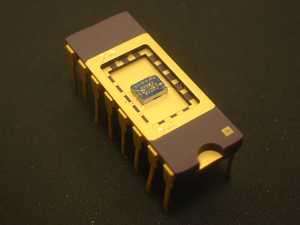Quantum device traps, detects and manipulates the spin of single electrons

A novel device, developed by a team led by University at Buffalo engineers, simply and conveniently traps, detects and manipulates the single spin of an electron, overcoming some major obstacles that have prevented progress toward spintronics and spin-based quantum computing.
Published online this week in Physical Review Letters, the research paper brings closer to reality electronic devices based on the use of single spins and their promise of low-power/high-performance computing.
“The task of manipulating the spin of single electrons is a hugely daunting technological challenge that has the potential, if overcome, to open up new paradigms of nanoelectronics,” said Jonathan P. Bird, Ph.D., professor of electrical engineering in the UB School of Engineering and Applied Sciences and principal investigator on the project.
“In this paper, we demonstrate a novel approach that allows us to easily trap, manipulate and detect single-electron spins, in a scheme that has the potential to be scaled up in the future into dense, integrated circuits.”
While several groups have recently reported the trapping of a single spin, they all have done so using quantum dots, nanoscale semiconductors that can only demonstrate spin trapping in extremely cold temperatures, below 1 degree Kelvin.
The cooling of devices or computers to that temperature is not routinely achievable, Bird said, and it makes systems far more sensitive to interference.
The UB group, by contrast, has trapped and detected spin at temperatures of about 20 degrees Kelvin, a level that Bird says should allow for the development of a viable technology, based on this approach.
In addition, the system they developed requires relatively few logic gates, the components in semiconductors that control electron flow, making scalability to complex integrated circuits very feasible.
The UB researchers achieved success through their innovative use of quantum point contacts: narrow, nanoscale constrictions that control the flow of electrical charge between two conducting regions of a semiconductor.
“It was recently predicted that it should be possible to use these constrictions to trap single spins,” said Bird. “In this paper, we provide evidence that such trapping can, indeed, be achieved with quantum point contacts and that it may also be manipulated electrically.”
The system they developed steers the electrical current in a semiconductor by selectively applying voltage to metallic gates that are fabricated on its surface.
These gates have a nanoscale gap between them, Bird explained, and it is in this gap where the quantum point contact forms when voltage is applied to them.
By varying the voltage applied to the gates, the width of this constriction can be squeezed continuously, until it eventually closes completely, he said.
“As we increase the charge on the gates, this begins to close that gap,” explained Bird, “allowing fewer and fewer electrons to pass through until eventually they all stop going through. As we squeeze off the channel, just before the gap closes completely, we can detect the trapping of the last electron in the channel and its spin.”
The trapping of spin in that instant is detected as a change in the electrical current flowing through the other half of the device, he explained.
“One region of the device is sensitive to what happens in the other region,” he said.
Now that the UB researchers have trapped and detected single spin, the next step is to work on trapping and detecting two or more spins that can communicate with each other, a prerequisite for spintronics and quantum computing.
Source: University at Buffalo




















